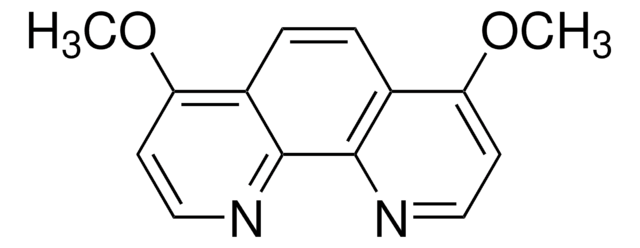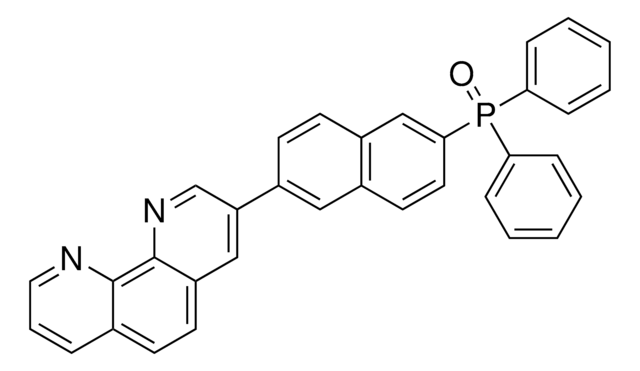932671
4,7-Diphenyl-1,10-phenanthroline
Synonym(s):
Bathophenanthroline, 4,7-Diphenyl-1,10-phenanthroline, BPhen
About This Item
Recommended Products
grade
sublimed grade
Quality Level
description
µe ≈ 3.0 x 10-4 cm2V-1s-1
Assay
≥99% (H-NMR)
form
powder
loss
0.5% TGA, >240ºC (weight loss)
mp
218-220 °C (lit.)
solubility
THF: soluble
chloroform: soluble
dichloromethane: soluble
λmax
272 nm in THF
fluorescence
λem 379 nm in THF
Orbital energy
HOMO 6.4 eV
LUMO 3.0 eV
SMILES string
c1ccc(cc1)-c2ccnc3c2ccc4c(ccnc34)-c5ccccc5
InChI
1S/C24H16N2/c1-3-7-17(8-4-1)19-13-15-25-23-21(19)11-12-22-20(14-16-26-24(22)23)18-9-5-2-6-10-18/h1-16H
InChI key
DHDHJYNTEFLIHY-UHFFFAOYSA-N
Looking for similar products? Visit Product Comparison Guide
Application
Storage Class Code
11 - Combustible Solids
WGK
WGK 3
Flash Point(F)
Not applicable
Flash Point(C)
Not applicable
Choose from one of the most recent versions:
Certificates of Analysis (COA)
It looks like we've run into a problem, but you can still download Certificates of Analysis from our Documents section.
If you need assistance, please contact Customer Support.
Already Own This Product?
Find documentation for the products that you have recently purchased in the Document Library.
Our team of scientists has experience in all areas of research including Life Science, Material Science, Chemical Synthesis, Chromatography, Analytical and many others.
Contact Technical Service





![Di-[4-(N,N-di-p-tolyl-amino)-phenyl]cyclohexane ≥97% (HPLC)](/deepweb/assets/sigmaaldrich/product/structures/111/787/16bde1ce-c76d-46d6-9e1f-9ce09f82d038/640/16bde1ce-c76d-46d6-9e1f-9ce09f82d038.png)